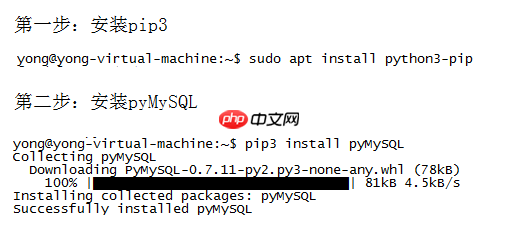交互类型
安装引入模块
安装
mysql
Windows
Ubuntu

在Windows中安装mysql模块:
立即学习“Python免费学习笔记(深入)”;

在Linux中安装mysql模块:
在文件中引入模块:
import pymysql
创建对象:调用
connect()
conn = connect(参数列表)
参数:
host
port
db
user
password
charset
close()
commit()
rollback()
cursor()
Cursor对象:
执行sql语句
创建对象:调用Connection对象的
cursor()
cursor1 = conn.cursor()
对象的方法:
close()
execute(operation [, parameters ])
fetchone()
next()
fetchall()
scroll(value[,mode])
mode
mode
relative
value
value
value
mode
absolute
# 导入python操作mysql的模块
import pymysql
<h1>获取连接对象</h1><p>conn = pymysql.connect(host='127.0.0.1', user='root', password='123456', database='python01', port=3306, charset='utf8')</p><h1>获取执行工具</h1><p>cur = conn.cursor()</p><h1>sql语句,增删改</h1><h1>sql = 'select birthday from t_user'</h1><p>sql = 'select id,name,pwd,birthday from t_user'</p><h1>执行,返回值。如果是增删改,返回受影响的行数,如果是查询,返回查询的行数</h1><p>count = cur.execute(sql)
print('查询的结果有%s条数据'%count)</p><h1>获取第一行</h1><p>dateOne = cur.fetchone()
print(dateOne)</p><h1>向上移动一行</h1><p>cur.scroll(-1)</p><h1>向下移动一行</h1><p>cur.scroll(1)</p><p>cur.scroll(1,mode='absolute') # 绝对的,这里指的是第一行
cur.scroll(1,mode='relative') # 相对的</p><h1>获取所有行的数据</h1><p>dataAll = cur.fetchall()
print(dataAll)</p><p>for temp in dataAll:
print(temp)
print(dataAll[-1][2]) #dataAll[-1]得到的是一个用户所有的信息,dataAll[-1][2]获取最后一个人的密码</p><p>for temp in cur:
print(temp)</p><p>s = 'id:%s,name:%s,pwd:%s,birthday:%s'
for temp in dataAll:
print(s%(temp[0],temp[1],temp[2],temp[3]))</p><h1>关闭</h1><p>cur.close()
conn.close()rowcount
execute()
connection
增删改查(CRUD)
增
创建
testInsert.py
#encoding=utf-8
import pymysql</p><p>try:
conn=pymysql.connect(host='localhost',port=3306,db='test1',user='root',passwd='mysql',charset='utf8')
cs1=conn.cursor()
count=cs1.execute("insert into students(sname) values('张良')")
print(count)
conn.commit()
cs1.close()
conn.close()
except Exception as e:
print(e)创建
testUpdate.py
#encoding=utf-8
import pymysql</p><p>try:
conn=pymysql.connect(host='localhost',port=3306,db='test1',user='root',passwd='mysql',charset='utf8')
cs1=conn.cursor()
count=cs1.execute("update students set sname='刘邦' where id=6")
print(count)
conn.commit()
cs1.close()
conn.close()
except Exception as e:
print(e)创建
testDelete.py
#encoding=utf-8
import pymysql</p><p>try:
conn=pymysql.connect(host='localhost',port=3306,db='test1',user='root',passwd='mysql',charset='utf8')
cs1=conn.cursor()
count=cs1.execute("delete from students where id=6")
print(count)
conn.commit()
cs1.close()
conn.close()
except Exception as e:
print(e)创建
testSelectOne.py
import pymysql</p><p>try:
conn=pymysql.connect(host='localhost',port=3306,db='test1',user='root',passwd='mysql',charset='utf8')
cur=conn.cursor()
cur.execute('select * from students where id=7')
result=cur.fetchone()
print(result)
cur.close()
conn.close()
except Exception as e:
print(e)创建
testSelectMany.py
#encoding=utf8
import pymysql</p><p>try:
conn=pymysql.connect(host='localhost',port=3306,db='test1',user='root',passwd='mysql',charset='utf8')
cur=conn.cursor()
cur.execute('select * from students')
result=cur.fetchall()
print(result)
cur.close()
conn.close()
except Exception as e:
print(e)实例一:参数
# 导入python操作mysql的模块
import pymysql
import time</p><h1>获取连接对象</h1><p>conn = pymysql.connect(host='127.0.0.1', user='root', password='123456', database='python01', port=3306, charset='utf8')</p><h1>获取执行工具</h1><p>cur = conn.cursor()</p><h1>sql语句,增删改,sql注入</h1><p>sql = 'insert into t_user(name,pwd,birthday) values(%s,%s,%s)'</p>
<div class="aritcle_card">
<a class="aritcle_card_img" href="/ai/%E4%BA%91%E9%9B%80%E8%AF%AD%E8%A8%80%E6%A8%A1%E5%9E%8B">
<img src="https://img.php.cn/upload/ai_manual/000/000/000/175680205024673.png" alt="云雀语言模型">
</a>
<div class="aritcle_card_info">
<a href="/ai/%E4%BA%91%E9%9B%80%E8%AF%AD%E8%A8%80%E6%A8%A1%E5%9E%8B">云雀语言模型</a>
<p>云雀是一款由字节跳动研发的语言模型,通过便捷的自然语言交互,能够高效的完成互动对话</p>
<div class="">
<img src="/static/images/card_xiazai.png" alt="云雀语言模型">
<span>54</span>
</div>
</div>
<a href="/ai/%E4%BA%91%E9%9B%80%E8%AF%AD%E8%A8%80%E6%A8%A1%E5%9E%8B" class="aritcle_card_btn">
<span>查看详情</span>
<img src="/static/images/cardxiayige-3.png" alt="云雀语言模型">
</a>
</div>
<h1>参数列表</h1><p>name = input('输入姓名:')
pwd = input('输入密码:')
birthday = input('输入生日:') # 2017年10月01日-->日期struct_time(--->2017-10-01)
birthday = time.strptime(birthday,'%Y年%m月%d日') #这里我们就用到了时间与字符串的相互转换(详情见MySQL高级)
params = [name,pwd,birthday]</p><h1>执行,返回值。如果是增删改,返回受影响的行数,如果是查询,返回查询的行数</h1><p>count = cur.execute(sql,params)</p><h1>提交</h1><p>conn.commit()
print('受影响的行数:%s'%count)</p><h1>关闭</h1><p>cur.close()
conn.close()实例二:抛出异常
# 导入python操作mysql的模块
import pymysql</p><p>try:
conn = None
cur = None</p><pre class="brush:php;toolbar:false;"><pre class="brush:php;toolbar:false;"># 获取连接对象
conn = pymysql.connect(host='127.0.0.1',
user='root',
password='123456',
database='python01',
port=3306,
charset='utf8')
# 模拟异常
# a = 1 / 0
# 获取执行工具
cur = conn.cursor()
# sql语句,增删改
sql = 'insert into t_user(name,pwd,birthday) values("小伊","123456",str_to_date("2017年10月20日","%Y年%m月%d日"))'
# 执行,返回值。如果是增删改,返回受影响的行数,如果是查询,返回查询的行数
count = cur.execute(sql)
# 提交
conn.commit()
print('受影响的行数:%s' % count)except Exception as ex:
<pre class="brush:php;toolbar:false;">print(str(ex)) # 将异常继续抛出 # raise
finally: if cur != None: cur.close() if conn != None: conn.close()
实例三:
# 导入python操作mysql的模块
import pymysql</p><h1>获取连接对象</h1><p>conn = pymysql.connect(host='127.0.0.1', user='root', password='123456', database='python01', port=3306, charset='utf8')</p><h1>获取执行工具</h1><p>cur = conn.cursor()</p><h1>sql语句,增删改</h1><h1>sql = 'select birthday from t_user'</h1><p>sql = 'select id,name,pwd,birthday from t_user'</p><h1>执行,返回值。如果是增删改,返回受影响的行数,如果是查询,返回查询的行数</h1><p>count = cur.execute(sql)
print('查询的结果有%s条数据'%count)</p><h1>获取第一行</h1><h1>dateOne = cur.fetchone()</h1><h1>print(dateOne)</h1><h1>for temp in cur:</h1><h1>print(temp)</h1><p>s = 'id:%s,name:%s,pwd:%s,birthday:%s'
for temp in dataAll:
print(s%(temp[0],temp[1],temp[2],temp[3]))</p><h1>关闭</h1><p>cur.close()
conn.close()这个库的名字:
mySqlHelper
# python操作mysql进行增删改查的封装</p><h1>1、增删改,代码类似</h1><h1>2、查询</h1><h1>代码分析</h1><h1>1、获取连接对象</h1><h1>2、sql语句不同,参数不同</h1><h1>3、获取执行对象</h1><h1>增删改</h1><h1>查询</h1><h1>1、fetchone</h1><h1>2、fetchall</h1><h1>4、处理结果</h1><h1>5、关闭</h1><h1>面向对象 建立类,封装属性和函数</h1><p>import pymysql</p><p>class MysqlHelper:
'''python操作mysql的增删改查的封装'''</p><pre class="brush:php;toolbar:false;"><pre class="brush:php;toolbar:false;">def __init__(self, host, user, password, database, port=3306, charset='utf8'):
'''
初始化参数
:param host: 主机
:param user: 用户名
:param password: 密码
:param database: 数据库
:param port: 端口号,默认是3306
:param charset: 编码,默认是utf8
'''
self.host = host
self.port = port
self.database = database
self.user = user
self.password = password
self.charset = charset
def connect(self):
'''
获取连接对象和执行对象
:return:
'''
self.conn = pymysql.connect(host=self.host,
user=self.user,
password=self.password,
database=self.database,
port=self.port,
charset=self.charset)
self.cur = self.conn.cursor()
def fetchone(self, sql, params=None):
'''
根据sql和参数获取一行数据
:param sql: sql语句
:param params: sql语句对象的参数元组,默认值为None
:return: 查询的一行数据
'''
dataOne = None
try:
count = self.cur.execute(sql, params)
if count != 0:
dataOne = self.cur.fetchone()
except Exception as ex:
print(ex)
finally:
self.close()
return dataOne
def fetchall(self, sql, params=None):
'''
根据sql和参数获取一行数据
:param sql: sql语句
:param params: sql语句对象的参数列表,默认值为None
:return: 查询的一行数据
'''
dataall = None
try:
count = self.cur.execute(sql, params)
if count != 0:
dataall = self.cur.fetchall()
except Exception as ex:
print(ex)
finally:
self.close()
return dataall
def __item(self, sql, params=None):
'''
执行增删改
:param sql: sql语句
:param params: sql语句对象的参数列表,默认值为None
:return: 受影响的行数
'''
count = 0
try:
count = self.cur.execute(sql, params)
self.conn.commit()
except Exception as ex:
print(ex)
finally:
self.close()
return count
def update(self, sql, params=None):
'''
执行修改
:param sql: sql语句
:param params: sql语句对象的参数列表,默认值为None
:return: 受影响的行数
'''
return self.__item(sql, params)
def insert(self, sql, params=None):
'''
执行新增
:param sql: sql语句
:param params: sql语句对象的参数列表,默认值为None
:return: 受影响的行数
'''
return self.__item(sql, params)
def delete(self, sql, params=None):
'''
执行删除
:param sql: sql语句
:param params: sql语句对象的参数列表,默认值为None
:return: 受影响的行数
'''
return self.__item(sql, params)
def close(self):
'''
关闭执行工具和连接对象
'''
if self.cur != None:
self.cur.close()
if self.conn != None:
self.conn.close()</code></pre><ol><li>测试查询多条数据</li></ol><pre><code class="javascript">import mysqlHelperhelper = mysqlHelper.MysqlHelper('127.0.0.1', 'root', '123456', 'python01')
helper.connect()
sql = 'select * from t_user where name = %s and id > %s'
params = ['小茗',1]
data = helper.fetchall(sql, params)
if data: for temp in data: print(temp) else: # None,False,0 print('没有数据.')
helper.close()
import mysqlHelper</p><h1>初始化对象</h1><p>helper = mysqlHelper.MysqlHelper('127.0.0.1', 'root', '123456', 'python01')</p><h1>连接</h1><p>helper.connect()</p><h1>sql</h1><p>sql = 'select * from t_user where id = %s'</p><h1>sql = 'select * from t_user where id = 1'</h1><h1>params</h1><p>params = [2]</p><h1>执行</h1><p>data = helper.fetchone(sql, params)</p><h1>data = helper.fetchone(sql)</h1><h1>判断</h1><p>if data:
print(data)
else: # None,False,0
print('没有数据.')import mysqlHelper
import time</p><h1>初始化对象</h1><p>helper = mysqlHelper.MysqlHelper('127.0.0.1', 'root', '123456', 'python01')</p><h1>连接</h1><p>helper.connect()</p><h1>sql</h1><p>sql = 'update t_user set name =%s,pwd=%s,birthday=%s where id=%s'</p><h1>params</h1><p>id = input('输入编号:')
name = input('输入姓名:')
pwd = input('输入密码:')
birthday = time.strptime(input('输入生日:'), '%Y年%m月%d日')
params = [name, pwd, birthday,id]</p><h1>执行</h1><p>count = helper.update(sql, params)</p><h1>判断</h1><p>if count:
print('操作成功.')
else: # None,False,0
print('操作失败.')登录和注册的时候需要对密码进行加密。
注意:
需要对密码进行加密,如果使用md5加密,则密码包含32个字符;如果使用sha1加密,则密码包含40个字符,这里使用这种方式。
create table userinfos(
id int primary key auto_increment,
uname varchar(20),
upwd char(40),
isdelete bit default 0);</p><p>/<em>ret = doPwd('123')
print(ret)
结果:40bd001563085fc35165329ea1ff5c5ecbdbbeef
</em>/</p><p>-- 插入如下数据,用户名为123,密码为123,这是sha1加密后的值
insert into userinfos values(1,'123','40bd001563085fc35165329ea1ff5c5ecbdbbeef',0);登录与注册:
from mysqlHelper import MysqlHelper
import hashlib</p><p>def login():
'''登录'''
name = input('输入用户名:')
pwd = input('输入密码:')</p><h1>加密</h1><pre class="brush:php;toolbar:false;"><pre class="brush:php;toolbar:false;">pwd = doPwd(pwd)
helper = MysqlHelper('127.0.0.1', 'root', '123456', 'python01')
helper.connect()
sql = 'select * from t_user where name=%s and pwd=%s'
params = [name, pwd]
data = helper.fetchone(sql, params)
if data:
print('登录成功.')
else: # None,False,0
print('登录失败.')def doPwd(pwd): '''sha1编码''' mysha1 = hashlib.sha1() mysha1.update(pwd.encode('utf-8')) pwd = mysha1.hexdigest() return pwd
def register(): '''注册''' name = input('输入用户名:') pwd = input('输入密码:')
<pre class="brush:php;toolbar:false;">pwd = doPwd(pwd)
helper = MysqlHelper('127.0.0.1', 'root', '123456', 'python01')
helper.connect()
sql = 'insert into t_user(name,pwd) values(%s,%s)'
params = [name, pwd]
count = helper.insert(sql, params)
if count:
print('操作成功.')
else: # None,False,0
print('操作失败.')if name == 'main':
<pre class="brush:php;toolbar:false;">login()</code></pre>
以上就是MySQL与Python的交互1.交互类型2.增删改查(CRUD)3.封装的详细内容,更多请关注php中文网其它相关文章!

每个人都需要一台速度更快、更稳定的 PC。随着时间的推移,垃圾文件、旧注册表数据和不必要的后台进程会占用资源并降低性能。幸运的是,许多工具可以让 Windows 保持平稳运行。

Copyright 2014-2025 https://www.php.cn/ All Rights Reserved | php.cn | 湘ICP备2023035733号